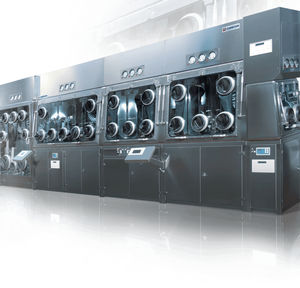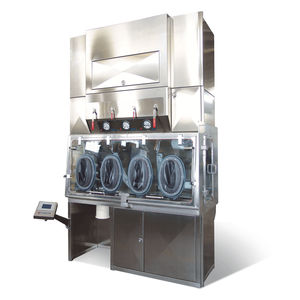
- Products
- Catalogs
- News & Trends
- Exhibitions
Class III isolator ATEX containmenttransferdispensing
Add to favorites
Compare this product
Characteristics
- Class
- class III
- Applications
- containment, dispensing, transfer, for weighing area, for powder handling
- Configuration
- floor-standing
- Other characteristics
- stainless steel
Description
The ATEX isolator is designed to carry out weighing and powder transfer procedures (API) in complete safety. The ATEX isolator consists of a chamber equipped with connections for scales and cable runs, with a front wall in glass which can be opened completely.
The chamber is also equipped with two spray balls and two spray guns for perfect cleaning.
Highlights
Fully PLC controlled
Software GAMP 5 compliant (21CFR Part 11 available upon request)
Friendly operator interface (HMI)
Sliding tray and internal storage systems made of stainless steel AISI 316L
Magnehelic manometers for the internal pressure control
Photohelic manometers to monitor clogging conditions of the air filter
Scale with remote panel
Sensors for monitoring the oxygen level
Automatic valves for air flow interception
DPTE 270-S ALPHA
The transfer and discharge of materials takes place by means of a RTP located on the right side of the chamber and a barrier sack with interlocking door located on the operating surface. Given the large quantity of rejects, the isolator was equipped with an automatic lift trolley which, placed under the barrier sack, allows accumulation of the rejects and therefore easy transport.
The internal work area is classified as ATEX ZONE 22 Ex II3D_/3, therefore a series of upgrades were adopted in the choice of improved solutions to ensure the handling of the highly explosive substances treated there.
The filtration system is composed of a single inlet stage inside the enclosure and a double output stage (one inside and one outside the enclosure). The ventilation system has the following modes based on the type of supply: Laboratory air, Process air and Nitrogen.
Related Searches
- Upright refrigerator
- 1-door refrigerator
- Laboratory refrigerator
- Stainless steel cupboard
- Laboratory incubator
- 1-door cupboard
- Stainless steel refrigerator
- Laboratory fume extractor
- Laboratory cupboard
- Stainless steel laboratory incubator
- Biological safety cabinet
- 1-station hand wash basin
- Metal sink
- Stainless steel hand wash basin
- Class II biological safety cabinet
- Comecer floor-standing isolator
- Comecer aseptic isolator
- Pass-through
- Floor-standing biological safety cabinet
- Carbon dioxide laboratory incubator
*Prices are pre-tax. They exclude delivery charges and customs duties and do not include additional charges for installation or activation options. Prices are indicative only and may vary by country, with changes to the cost of raw materials and exchange rates.


















